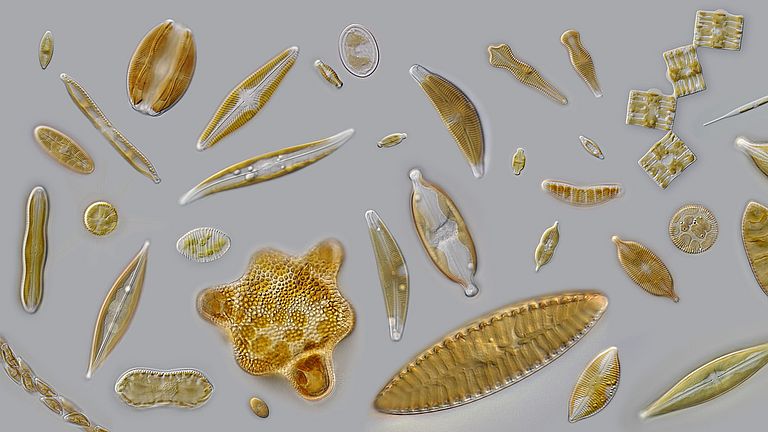Anna Niewerth
Phone: +49 (0) 431 600 2812
E-Mail: aniewerth(at)geomar.de
Environmental change coping mechanism discovered in humble algae
A Light-Driven Proton Pump can compensate for nutrient deficiency and enhance growth
Joint Press Release of the University of Würzburg, and the GEOMAR Helmholtz Centre for Ocean Research Kiel
An international research team from the GEOMAR Helmholtz Centre for Ocean Research Kiel, the School of Environmental Sciences at the University of East Anglia (UEA), and the Physiological Institute of the University of Würzburg has found how diatoms compensate for nutrient deficiency. Their discovery could help mitigate the adverse effects of climate change. The study is published today in the journal Nature Microbiology.
The corresponding authors of the study are Thomas Mock, Professor of Marine Microbiology at UEA, and his former doctoral student Jan Strauss, who continued the work after completing his Ph.D. as a postdoctoral researcher at the European Molecular Biology Laboratory (EMBL) in Hamburg and in the laboratory of Professor Dr Alexandra Z. Worden, founder of the Ocean Ecosystems Biology Research Unit at GEOMAR and a Fellow of the Max Planck for Evolutionary Biology in Plön. Professor Dr Georg Nagel and Dr Shiqiang Gao from the Department of Neurophysiology at the University of Würzburg also contributed to the research.
The team studied the so-called eukaryotic phytoplankton, which are plant-like organisms also referred to as microalgae, found over large parts of the ocean. In the process, the scientists discovered the algae have found a way to cope with nutrient starvation, which is predicted to increase due to warming waters. This is good news for the food chain – marine microalgae are the base of the largest food web on Earth including krill, fish, penguins, and whales – and they remove carbon dioxide (CO2) from the atmosphere while producing oxygen.
“For algae to produce food and to remove CO2 from the atmosphere, they need sunlight”, explains Professor Dr Thomas Mock. Additionally, the cellular machinery requires a significant amount of iron to harness sunlight. However, in 35 percent of the ocean's surface, there is insufficient iron to support algae growth. “In these areas algal productivity should be much more reduced, similar to land plants such as crops that lack iron- and nitrogen-rich fertiliser, meaning crops will not grow that well.”
Climate change is expected to exacerbate this effect: “Global warming is increasing drought on land and the same thing happens in the ocean: the warmer the surface water gets, the lower are the nutrients in these surface water layers because of reduced mixing that usually adds nutrients from the deeper ocean”, says Mock. As a result, algae were supposed to starve and therefore produce less food and take up less CO2 from the atmosphere.
The research team discovered that algae have found a way to cope with nutrient starvation, particularly iron, by evolving an additional cellular machinery that allows them to use sunlight for growth without the need for iron. Dr Jan Strauss explains: “Some groups of microalgae can circumvent photosynthesis by using a light-driven proton pump to fuel growth”.
Instead of relying on photosynthetic proteins that require iron, the algae employ a light-sensitive membrane protein called rhodopsin, which is related to a protein in human eyes. These proteins do not require iron, and one specific group of them pumps protons through membranes, enabling the synthesis of ATP (Adenosine Triphosphate), the universal energy carrier in all cells - one of the key functions of photosynthesis in all photosynthetic organisms.
During their collaborative work in Georg Nagel's laboratory, Shiqiang Gao successfully cloned the algae rhodopsins. Using specialized electrophysiological methods, he then demonstrated their effective proton-pumping capability, even at low temperatures prevalent, for example, in the Southern Ocean.
Thomas Mock summarizes the central result of the study, saying, “Thanks to this simple cellular machinery, these algae can still thrive in iron-poor surface oceans, and it is therefore also likely they will be able to cope with global warming as they are preconditioned”.
Potentially, the discovery could be used to enhance the productivity of crops, which also require iron for growth, Prof Mock says. “This is universal for all primary producers. This machinery can also be used in biotechnology to enhance the productivity of microbes that cannot use light such as yeast. We can modify them so that they can use light for growth, which is desirable in biotechnology, for example, in the production of insulin, antibiotics, enzymes, antivirals, or biofuel”.
The team’s work is particularly relevant for the Southern Ocean, which is both the largest iron-limited aquatic ecosystem and among the most productive, supporting the largest populations of algae consumers. Prof Mock says: “No other habitat on Earth is more important than our oceans for the survival of humans and life in general”.
Publication:
Strauss, Jan et al. Plastid-localized xanthorhodopsin increases diatom biomass and ecosystem productivity in iron-limited surface ocean. Nature Microbiology.
DOI: 10.1038/s41564-023-01498-5
https://www.nature.com/articles/s41564-023-01498-5
Funding:
Jan Strauss' PhD was funded by the School of Environmental Sciences at UEA. He also received a grant from the EMBL Interdisciplinary Postdoc Programme (EIPOD) under the Marie Sklodowska-Curie Actions COFUND programme (grant number 664726). Other funding has been provided by the GEOMAR Helmholtz Centre for Ocean Research Kiel and the Gordon and Betty Moore Foundation (grant 3788 to Alexandra Z. Worden) and the Natural Environment Research Council.

The Southern Ocean is both the largest iron-limited aquatic ecosystem and among the most productive, supporting the largest populations of algae consumers. Photo: Martin Visbeck/GEOMAR

A phytoplankton bloom swirls a figure-of-8 in the South Atlantic Ocean: Different types and quantities of phytoplankton exhibit different colours, such as the blues and greens in this image. Photo: ESA, CC BY-SA 3.0 IGO

A vital component of phytoplankton: Diatoms, a specific group of microalgae. Photo: Oliver Skibbe.

Phytoplankton bloom forming of a dense mat of diatoms in the Southern Ocean. Photo: University of Hawaii/E. Goetze


